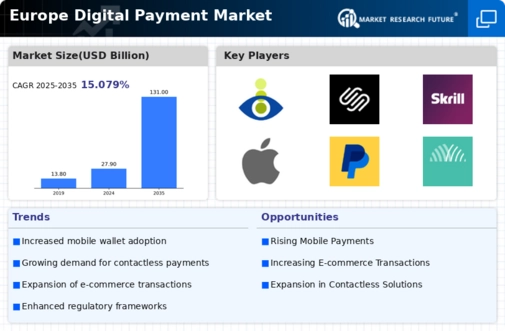Growing E-commerce Sector
The expansion of the e-commerce sector significantly influences the Europe Digital Payment Market. As online shopping continues to gain traction, the demand for efficient and secure digital payment solutions escalates. Recent data indicates that e-commerce sales in Europe have reached unprecedented levels, with projections suggesting a compound annual growth rate of over 10% in the coming years. This surge in online transactions necessitates the adoption of diverse payment methods, including digital wallets and mobile payments, to cater to consumer preferences. Consequently, the growth of e-commerce is expected to propel the Europe Digital Payment Market, creating new opportunities for payment service providers.
Consumer Demand for Convenience
Consumer preferences are evolving, with a marked shift towards convenience in payment methods. The Europe Digital Payment Market is responding to this trend by offering a variety of user-friendly payment solutions. The rise of mobile payments and digital wallets reflects a growing desire for quick and hassle-free transactions. Recent surveys indicate that over 60% of consumers prefer contactless payments for their speed and ease of use. This demand for convenience is likely to drive innovation within the industry, as businesses strive to enhance user experiences and streamline payment processes, ultimately contributing to the growth of the Europe Digital Payment Market.
Regulatory Support and Compliance
The regulatory landscape plays a crucial role in shaping the Europe Digital Payment Market. Governments and regulatory bodies are increasingly implementing frameworks that promote secure and efficient digital payment solutions. The European Union's Payment Services Directive 2 (PSD2) has been instrumental in fostering competition and innovation within the market. By mandating strong customer authentication and encouraging open banking, PSD2 enhances consumer protection while facilitating access to diverse payment options. This regulatory support is likely to drive market growth, as businesses adapt to comply with these standards, thereby increasing consumer confidence in digital payment systems.
Increased Investment in Fintech Solutions
Investment in fintech solutions is a driving force behind the evolution of the Europe Digital Payment Market. Venture capital funding for fintech startups has surged, with billions of euros being allocated to innovative payment technologies. This influx of capital is fostering the development of new payment platforms and services that cater to diverse consumer needs. As fintech companies introduce cutting-edge solutions, traditional financial institutions are compelled to adapt, leading to a more competitive landscape. This dynamic environment is likely to stimulate further advancements in digital payment systems, positioning the Europe Digital Payment Market for robust growth in the foreseeable future.
Technological Advancements in Payment Systems
The Europe Digital Payment Market is experiencing a notable transformation driven by rapid technological advancements. Innovations such as blockchain technology and artificial intelligence are reshaping payment processing, enhancing efficiency and security. For instance, the integration of AI in fraud detection systems has led to a reduction in transaction-related risks, fostering consumer trust. Moreover, the adoption of contactless payment methods has surged, with a reported increase of over 30% in usage across various sectors. This technological evolution not only streamlines transactions but also caters to the growing demand for seamless payment experiences, positioning the Europe Digital Payment Market for sustained growth.

















Leave a Comment